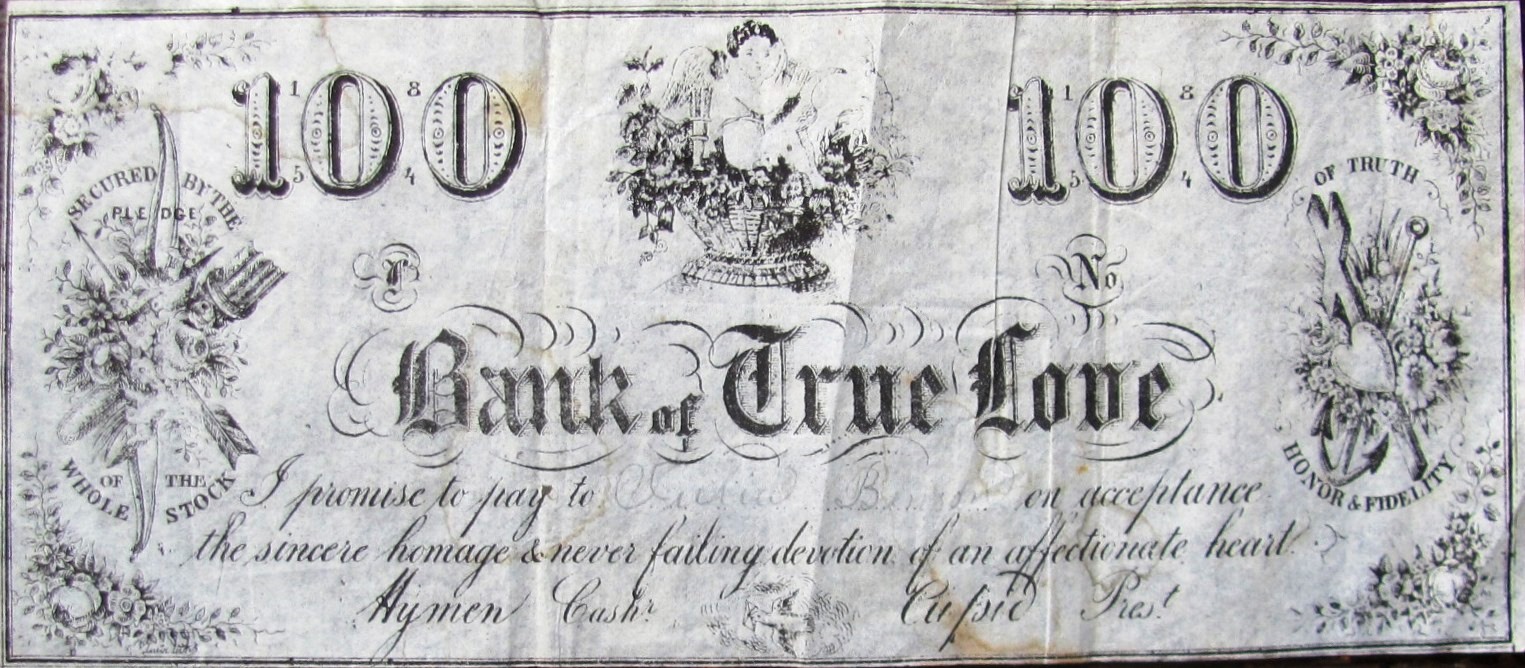
The photo with this article is an early valentine. It’s a tad larger than a current $1 bill. The paper is very thin and flimsy. I know this as “lace paper.”
The denomination is 100; other denominations and themes exist. They were produced in the 1840s and 1850s. This valentine dates to 1854.
At top center, Cupid sits atop a basket of flowers. To the left and right is “100.” At left it reads, “Secured by the Pledge of the Whole Stock.” “Bank of True Love” occupies the center. At right, “Of Truth Honor & Fidelity.”
Below Bank of Love is, “I promise to pay [a blank space to write in the recipient’s name. On this valentine, ‘Julia Benson’ is written in] on acceptance the sincere homage & never failing devotion of an affectionate heart.”
Below that, at left, is, “Hymen Cash’r” and at right “Cupid Pres’t.”
I found some history online regarding these early valentines.
“Other varieties of design themes included nautical and classical features. Early 19th century war and nautical activities were common concerns for Britain and America so it is not surprising sailors and ships figure into the early designs of valentines. They were identifiable images and themes of concern for those giving love tokens as well as those receiving them.
“Stationers concocted such novelties as the 1840s ‘Bank of True Love’ notes to pledge love and fidelity to the recipient while closely resembling currency of the times. Other early engraved valentines depicted couples in romantic scenes.”
These valentines were printed in Philadelphia and other major cities. A peddler or drummer traveled throughout New England selling these valentines to stores and druggists along the way. Even the smallest towns would have had these valentines for sale to the public.
I picked up this valentine about 10 years ago from the Marjorie Boynton Cross estate. It came in a lot of early letters, dating as far back as 1808. Marjorie grew up on Boynton Road in Weston Island. She graduated Chester High School in 1941, and later married Al Cross. They ran Al’s IGA for many years.
The letters are written to Ingraham, Boynton, and other family members. Over time, the spelling of Ingraham changed to “Ingram.” There are also letters from the Benson family. Most correspondence is to area towns; Windham, Bondville, Townsend, Derry, and such. There are a few letters from Oklahoma in the 1880s that detail building a sod house. Another letter from Bondville describes the March 1888 blizzard. A genealogist would have fun figuring out all of the players and who married who.
Lace paper, as I know it, is very similar to the paper used on bank notes in the first half of the 19th century. Like those bank notes, this valentine is printed on the front only. The reverse is blank. The reason it was done this way is because the paper is so thin, printing on the reverse would have bled through to the front. It’s a very durable paper that survives to this day.
Happy Valentine’s Day!
Instead of an old saying, I offer a short story. It was back in the 1980s, my girlfriend at the time liked to watch “Poirot” and “All Creatures, Great and Small” on PBS.
We were watching “Poirot” one night. Poirot was on a cruise ship standing on deck. A lady walked through the frame leading a small dog on a leash. My girlfriend asked where dogs did their business on a ship. “On the poop deck,” I said.